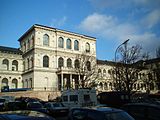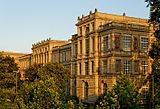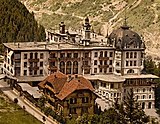Neo-renaissance

Neo-renaissance (from ancient Greek νέος néos , German 'new' ) or neo-renaissance is a direction of historicism in the 19th century, in which the architecture of the Renaissance is used. Depending on the individual case, the forms come primarily from the repertoire of the Italian Renaissance or mainly from the German Renaissance or Nordic Renaissance of the 16th century.
description
From 1830 onwards, the prevailing classical style was gradually replaced by neo-Gothic and neo-Renaissance. Since the architecture of the Neo-Renaissance is in principle based on the same ancient formal language as Classicism , the dividing line between the two styles cannot always be clearly drawn. The first neo-Renaissance buildings in England are the Travelers Club (1829) and the Reform Club (1837) by Charles Barry (in London), in Germany Klenzes Palais Leuchtenberg from 1821 and the royal building of the Munich Residence . In France, even the architecture of Napoleon I's time is partly based on Renaissance models. The style prevailed under the "citizen king" Louis-Philippe I (from 1830) in the restoration and interior decoration of various castles. The French version of the Renaissance since King Francis I is used as a model. This is how national branches of the Neo-Renaissance emerge, which imitate the country's own style variants, such as the "German Renaissance" or the architecture of Tudor England in the New Tudor style . Other architects such as Gottfried Semper cling more closely to the example of the Italian Renaissance.
The Neo-Renaissance had its greatest impact between 1870 and 1885, when its forms were considered exemplary in strict historicism . This replaced romantic historicism , in which the subjective interpretation of the architect determined the style of the building. Their forms were propagated by Gottfried Semper and Hermann Nicolai ( Semper Nicolai School ), by Rudolf Eitelberger , the founder of the Vienna School of Applied Arts , and by other important architects of the time. In Vienna in particular, entire streets are designed in neo-Renaissance designs, not least on Vienna's Ringstrasse .
After the allocation of certain styles for certain building tasks, which is customary in historicism, the neo-renaissance was primarily intended for banks, town houses and educational institutions. As with the Neo-Gothic, some structures from the Renaissance were added, for example the addition of the lavish facade of St. Michael in Aachen .
At about the same time, the neo-baroque developed , which from 1885 began to replace the hegemony of the neo-renaissance. The neo-renaissance also found expression in interiors, in church furnishings and in furniture construction . It ended - with a few exceptions for furniture - around 1900.
- Examples of Neo-Renaissance architecture
Ringstrasse Palace Hansen in Vienna (2010)
Villa Berg in Stuttgart (2005)
Town hall in Bielitz-Biala (2008)
Reading room of the University Library Graz (2003)
Neo-Renaissance altar by Moriz Schlachter in the parish church of St. Gangolf in Wolpertswende (2006)
Art Academy , Munich (2005)
Art Academy in Düsseldorf-Altstadt , from the northwest (2009)
Recklinghausen Town Hall (2015)
Boitzenburg Castle (2018)
Hotel Waldhaus Vulpera (1897)
European examples
- The Rijksmuseum in Amsterdam
- Cathedral of St. Dionysius Areopagita , Athens
- Iliou Melathron , Athens
- National Theater , Athens
- Friedrichsbad , Baden-Baden
- Reichstag building , Berlin
- Britz Castle , Berlin
- Villa Oppenheim , Berlin
- Federal Palace (west wing), Bern
- Brussels Royal Conservatory , Brussels
- St. Stephen's Basilica , Budapest
- Opera house and other buildings on Andrássy Street in Budapest
- Voldagsen manor , Coppenbrügge
- Old Masters Picture Gallery , Dresden
- Villa San Remo , Dresden
- First Semperoper , Dresden
- Alte Oper , Frankfurt am Main
- Central station , Frankfurt am Main
- Extension of the local town hall , Görlitz
- Town house , Halle on the Saale
- The regional court in Halle an der Saale
- Harburg Town Hall (" Weser Renaissance "), Hamburg
- Hamburg City Hall , Hamburg
- Brick building of the Hamburger Kunsthalle , Hamburg
- Highclere Castle , England
- German Consulate General , Istanbul
- City Hall West , Karlsruhe
- Gut Mielenforst , Cologne
- City Hall, Copenhagen
- Charlottenlund Palace near Copenhagen
- Imperial Court Building , Leipzig
- University Library , Leipzig
- Bagatti Valsecchi Museum , Milan
- Melkof Castle , Melkof in Mecklenburg-Western Pomerania
- Art Academy Düsseldorf , Düsseldorf
- Art Academy , Munich
- Krickenbeck Castle , Nettetal
- Town Hall, Odense
- Hotel de Ville , Paris
- National Museum , Prague
- Luther Church , Radebeul
- Town hall , Recklinghausen
- Old District Court, Recklinghausen
- Willy Brandt House , Recklinghausen
- Schwerin Castle (reconstruction), Schwerin
- Villa Haas , Sinn (Hesse)
- Palais du Rhin (formerly the Imperial Palace), Strasbourg
- Main building of the University of Strasbourg , Strasbourg
- Villa Berg , Stuttgart
- Vettelhoven Castle , County of Vettelhoven (near Bonn)
- New Museum , Weimar
- Kunsthistorisches Museum Wien , Vienna
- Palais Hansen , Vienna
- University of Vienna , Vienna
- Vienna State Opera , Vienna
- New Town Hall , Wiesbaden
- Main station , Zurich
- Vierordtbad , Karlsruhe, first construction phase by Josef Durm
- Wuppertal City Hall , Wuppertal
- Hotel Waldhaus Vulpera , Vulpera
- Bad Homburg train station , Bad Homburg
Examples overseas
- Dunedin Railway Station , Dunedin, New Zealand
- The Breakers , Newport
- Château style , Canada
See also
literature
- Kurt Milde: Neo-Renaissance in 19th Century German Architecture. Basics, essence and validity . Verlag der Kunst, Dresden 1981.
- Daniela Biffar: Neo-Renaissance jewels. The jewelery manufacturer Hermann Bauer (1833–1919) . Edition Hatje, Ostfildern-Ruit 1996, ISBN 3-7757-0638-0 .
- Walter Krause (Ed.): Neorenaissance. Demands on a style . Verlag der Kunst, Dresden 2001, ISBN 3-929744-03-1 .
Individual evidence
- ^ The breakdown into the style phases Romantic Historicism - Strict Historicism - Late Historicism goes back to the Austrian art historian Renate Wagner-Rieger .









